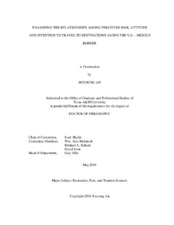| dc.description.abstract | In order to understand the role of borders in tourism, research needs to examine how tourists perceive a border; if tourists perceive the same types of risk as they do when they travel to other tourist destinations. The purpose of this study is to identify salient dimensions of perceived risk and relationships among antecedent variables such as past travel experiences, culture, destination familiarity, perceptions of travel risk in the context of the U.S.-Mexico border and tourists’ attitudes and intentions to visit destinations along the U.S. – Mexico border.
Data was collected from Texas residents age 18 and above through an online panel survey. A total of 488 responses were gathered. Several statistical analyses were utilized for hypothesis testing: Factor analysis, an Independent T-test, a Paired Sample T-test, ANOVA and SEM. In the current study, five dimensions of risk perception were identified; ‘Personal Safety,’ ‘Conveniences,’ ‘Border Patrol Concerns,’ ‘Border Patrol Importance,’ and ‘Communication Concern.’ The major results are as follows: 1) Asians perceived a higher risk of ‘Border Patrol Concerns’ when considering not crossing the border into Mexico and Caucasians perceived a higher risk of ‘Communication Concern’ when considering crossing the border. 2) Respondents with no Spanish speaking skill perceived higher levels of risk of ‘Personal Safety’ and ‘Conveniences’ when considering not crossing the border into Mexico while respondents with Spanish speaking skill perceived higher levels of risk of ‘Personal Safety,’ ‘Conveniences,’ ‘Border Patrol Concerns,’ and ‘Communication Concern’ when considering crossing the border into Mexico. 3) Respondents perceived higher risk when considering travel to a rural region than an urban region. 4) Media exposure and familiarity with a destination were found to be a significant predictor influencing perceived risk in both cases. 5) A negative relationship between perceived risk and attitude and a positive relationship between attitude and intention have been identified in both cases. Based on the results, several suggestions are made. First, positively worded information should be provided for tourists to help them understand border procedures as well as information regarding tourist facilities in the border region. Second, providing information in different languages especially in English would be helpful to reduce the levels of communication risk for potential tourists. Third, tourism practitioners should monitor information being dispersed through the influential sources related to a destination for their unique target markets. If misinformation is found, it should be corrected properly before potential tourists perceive it as reality. Lastly, it will be important to share positive travel experiences by tourists who traveled to the border region through social media to reduce unnecessary perceived risk or fear for potential tourists who consider traveling to border regions. | en |


